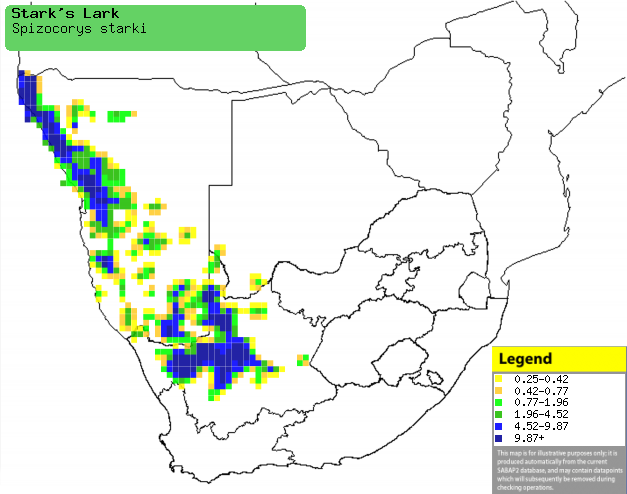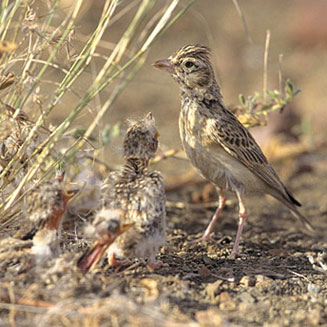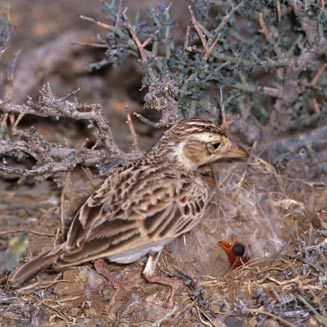|
Spizocorys starki (Stark's
lark)
Woestynlewerik [Afrikaans]; Alouette de Stark [French];
Starks kurzhaubenlerche [German]; Cotovia de Stark [Portuguese]
Life
> Eukaryotes >
Opisthokonta
> Metazoa (animals) >
Bilateria >
Deuterostomia > Chordata >
Craniata > Vertebrata (vertebrates) > Gnathostomata (jawed
vertebrates) > Teleostomi (teleost fish) > Osteichthyes (bony fish) > Class:
Sarcopterygii (lobe-finned
fish) > Stegocephalia (terrestrial
vertebrates) > Tetrapoda
(four-legged vertebrates) > Reptiliomorpha > Amniota >
Reptilia (reptiles) >
Romeriida > Diapsida > Archosauromorpha > Archosauria >
Dinosauria
(dinosaurs) > Saurischia > Theropoda (bipedal predatory dinosaurs) >
Coelurosauria > Maniraptora > Aves
(birds) >
Order: Passeriformes > Family: Alaudidae
> Genus: Spizocorys
Distribution and habitat
Near-endemic to southern Africa, occurring from
south-western Angola through Namibia to the Northern Cape and south-western
Botswana. It generally prefers arid or semi-arid plains with scattered shrubs
and grass tufts, especially with gravel or stones over sandy soil.
|
 |
|
Distribution of Stark's lark in southern Africa,
based on statistical smoothing of the records from first SA Bird Atlas
Project (©
Animal Demography unit, University of
Cape Town; smoothing by Birgit Erni and Francesca Little). Colours range
from dark blue (most common) through to yellow (least common).
See here for the latest distribution
from the SABAP2. |
Movements and migrations
Nomadic, moving in flocks ranging from only 4-5
birds to several thousand, all of which diverge on areas which have
experienced recent rainfall.
Food
It mainly eats grass seeds supplemented with arthropods,
doing its foraging on the ground, plucking food items from the sand. The following food items have been recorded
in its diet:
- Seeds
- grass
- Aristida
- Brachiara glomerata (signal grass)
- Enneapogon
- Stipagrostis ciliata (Tall bushman grass)
- Stipagrostis obtusa (Kortbeenboesmangras)
- Schmidtia kalihariensis (Kalaharisandkweek)
- forbs
- Cleome
- Giseckia
- Galenia
- Monsonia umbellata (Wilderabassam)
- Arthropods
Breeding
- The nest is a cup built of the white silky inflorescences and awns of
grasses (especially Aristida and Stipagrostis), placed in an
excavated hollow at the base of a shrub, grass tuft or rock. Occasionally it
constructs the nest out in the open, especially in winter when it is not
quite as hot.
 |
 |
|
Stark's lark at its nest with chicks, Maltahöhe,
Namibia. [photo
Warwick Tarboton ©] |
Stark's lark with chick in nest. [photo Peter
Steyn ©] |
- It can lay its eggs at any time of year, as it opportunistically breeds
after heavy rainfall. However, egg-laying season usually peaks around
March-May, coinciding with late summer rainfall and bushman grasses (Stipagrostis)
setting seed.
- It lays 1-7, usually 2-3 eggs, which are incubated by both sexes for
about 22-26 days.
- The chicks are cared for by both parents, leaving the nest at about 20
days old. They usually fledge about 10 days later, becoming fully
independent about 2 weeks later.
Threats
Not threatened.
References
-
Hockey PAR, Dean WRJ and Ryan PG 2005. Roberts
- Birds of southern Africa, VIIth ed. The Trustees of the John Voelcker
Bird Book Fund, Cape Town.
|
